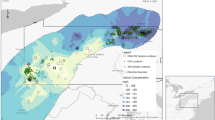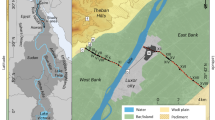Abstract
WELSH rivers and lakes are remarkably free from domestic and industrial pollutants, but because of the presence of mineral deposits and the remains of mining activities, they are likely to have small but significant concentrations of heavy metals that may cause severe deterioration of the water quality. For example, the presence of lead, zinc and copper in some Welsh streams causes a high mortality rate in fish and other living populations of these streams1–5, and the heavy metals carried to the sea by Welsh rivers are the primary source of these metals in Cardigan Bay6. But since the cessation of mining activities in the early part of this century, it has been reported that some rivers have shown some degree of recovery from the effects of lead pollution7,8. Only limited information is available concerning the heavy metals in Welsh rivers, and most of this is not entirely reliable as an indicator of the present level of metals in the water. Here we report an investigation of the heavy metal content of rivers and lakes in Wales carried out from September 1970 to October 1971. The River Dee and its tributaries were examined between July 1968 and April 1969. Samples were taken from the positions shown in Fig. 1 at monthly intervals. Seven trace metals and the major ions were determined. The trace metals were separated by chelating resins and analysed using pulse polarography9 or atomic absorption spectrophotometry.
This is a preview of subscription content, access via your institution
Access options
Subscribe to this journal
Receive 51 print issues and online access
$199.00 per year
only $3.90 per issue
Buy this article
- Purchase on Springer Link
- Instant access to full article PDF
Prices may be subject to local taxes which are calculated during checkout
Similar content being viewed by others
References
Carpenter, K. E., Ann. Appl. Biol., 9, 1 (1924).
Carpenter, K. E., Brit. J. Exp. Biol., 4, 378 (1927).
Carpenter, K. E., J. Exp. Zool., 56, 407 (1930).
Jones, J. R. E., J. Anim. Ecol., 9, 188 (1940).
Jones, J. R. E., Ann. Appl. Biol., 27, 368 (1940).
Abdullah, M. I., Royle, L. G., and Morris, A. W., Nature, 235, 158 (1972).
Laure, R. D., and Jones, J. R. E., J. Anim. Ecol., 7, 272 (1938).
Jones, A. N., and Howells, W. R., Effl. Wat. Treat. J., 9, 605 (1969).
Abdullah, M. I., and Royle, L. G., Anal. Chim. Acta, 58, 283 (1972).
Jones, J. R. E., J. Anim. Ecol., 27, 1 (1958).
Thomas, T. M., The Mineral Wealth of Wales and its Exploitation (Oliver and Boyd, London, 1961).
Author information
Authors and Affiliations
Rights and permissions
About this article
Cite this article
ABDULLAH, M., ROYLE, L. Heavy Metal Content of Some Rivers and Lakes in Wales. Nature 238, 329–330 (1972). https://doi.org/10.1038/238329a0
Received:
Revised:
Issue Date:
DOI: https://doi.org/10.1038/238329a0
This article is cited by
-
The influence of acidic mine and spoil drainage on water quality in the mid-Wales area
Environmental Geochemistry and Health (1991)
-
Heavy metals in water, sediments, fish and plants of river Hindon, U.P., India
Hydrobiologia (1987)
-
Consequences of environmental contamination by lead mining in Wales
Hydrobiologia (1987)
-
Silver and other metals in some aquatic bryophytes from streams in the lead mining district of Mid-Wales, Great Britain
Water, Air, and Soil Pollution (1985)
-
The recovery of the river Twymyn from lead mine pollution and the zinc loading of the recolonising fauna
Minerals and the Environment (1981)
Comments
By submitting a comment you agree to abide by our Terms and Community Guidelines. If you find something abusive or that does not comply with our terms or guidelines please flag it as inappropriate.



